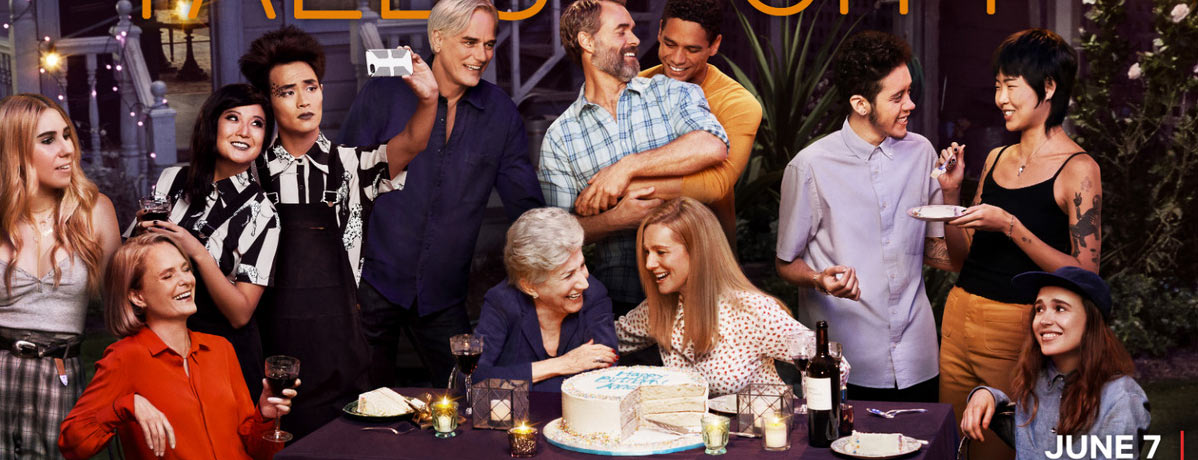Maybe this series was always just waiting for Netflix. The first Tales of the City mini-series, which debuted on PBS in 1994, dared to show two men kissing and waking up in bed together, an underwear contest in a gay bar, a wealthy white woman getting pregnant by a Chinese delivery boy, a lesbian relationship between a latter-day hippy and a fashion model, and a transgender landlady who grew marijuana in her garden. For this, government funding to PBS was nearly cut off as right-wing America declared Public Broadcasting another liberal Trojan horse in the culture wars. The controversy was so great that the subsequent two series weren’t made until 1998 and 2001, and were produced by Showtime and Channel Four, rather than Public Television.
Imagine what Bob Dole would say now. With the freedom of a twenty-first century streaming service, Tales of the City continues to break new ground in “mainstream” television. The Netflix series features polyamory, naked queer performance art, drag galore, and a pervasive cloud of legalized weed.
More importantly, queer people of color take central roles in the story, expressing fully-realized personalities, problems, joys, struggles, and sexuality on screen.
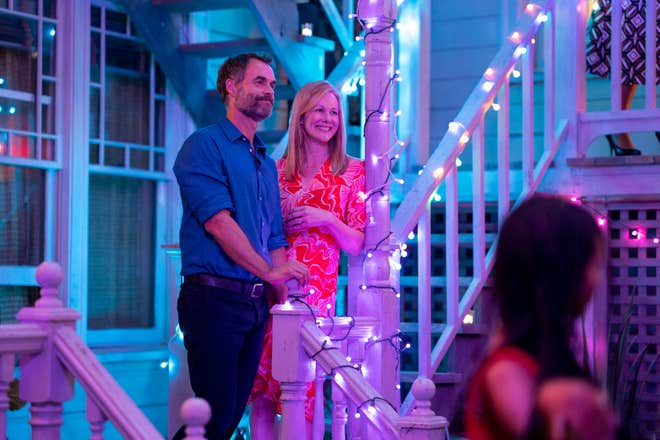
In the first episode of the ten-episode limited series, Mary Ann Singleton (Laura Linney) returns to 28 Barbary Lane to celebrate her former landlady Anna Madrigal’s (Olympia Dukakis) 90th birthday. Greeting her are her ex-husband Brian Hawkins (Paul Gross) and her gay best friend Michael “Mouse” Tolliver (Murray Bartlett). Michael is still living at Barbary Lane, dating a man half his age. A new generation of “Barbarians” continues to give the place its bohemian vibe. Chief among these is Shawna (Ellen Page), the now-grown adopted daughter Mary Ann and Brian, whom Mary Ann left behind twenty years prior to follow a TV career on the East Coast.
It’s a fine beginning that has the feel of a family reunion. But the question of canon pervades the Netflix adaptation. This Tales of the City is certainly a “reboot” of the story after the last three books of the series Michael Tolliver Lives, Mary Ann in Autumn, and The Days of Anna Madrigal were published between 2008 and 2014.
In the books, 28 Barbary Lane has already been sold and Anna is living in an apartment in Duboce Triangle. Michael Tolliver had long since moved out, living in a cottage in Noe Valley. The story arcs for Brian, Mary Ann, and Shawna in the books are similar to what you see in the TV series, but not exactly the same.
It makes sense that Anna and Michael would still be living at 28 Barbary Lane for the Netflix series. The rambling Victorian complex on Russian Hill is really like another character in the TV incarnations of Tales.
The addition and recasting of other characters for the Netflix series are a definite plus. Murray Bartlett is the third actor to play Michael Tolliver on television. He’s such a perfect match for the character, you wish he could go back in time and play “Mouse” from the beginning. In the books, Michael’s younger boyfriend is Ben McKenna, a white man he met on a dating site for “mature” gay men, similar to Daddyhunt. But casting Charlie Barnett, an openly-gay African-American actor, as the Millennial Ben Marshall in the series ads depth and diversity to their relationship. (Plus, Charlie Barnett? Woof!)
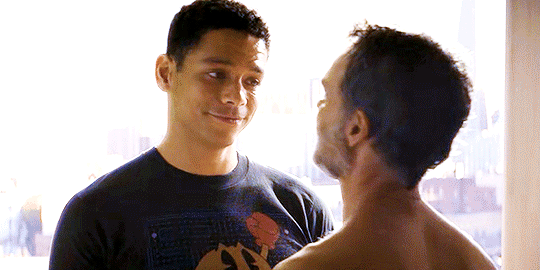
couple in Tales of the City.
Similarly, a lonely trans man named Jake Greenleaf in the books is recast as Jake Rodriguez (played by genderqueer actor Garcia) a trans man living at Barbary Lane with his girlfriend, Margot Park (May Hong). Their storyline is a rare and moving one for mainstream TV.
Post-transition, Jake struggles with his sexual orientation, finding himself increasingly attracted to men, which strains his relationship with Margot, who still sees herself as a lesbian.
“I miss being a lesbian.” Margot complains to Shawna in one scene, “I always dreamed I’d have a wife and kids. We’d take road trips to Carmel, get a pug from a rescue.” Shawna responds, “It’s very 90s of you.”
Hong and Garcia are the breakout stars of the series, and come awards season, it will be interesting to see if the Golden Globes and Emmys can make space in their gender-based system to recognize non-binary actors.
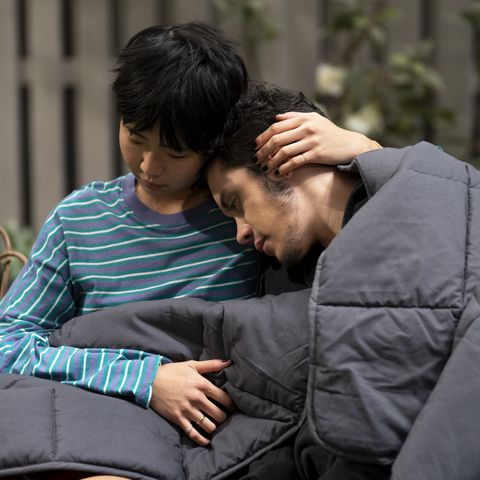
Other great characters added to the lineup include Wrenita Butler (Michelle Buteau) Brian’s neighbor-with-benefits; Claire Duncan (Zosia Mamet) a militant queer documentarian; Mateo (Dickie Hearts) a gay deaf butler obsessed with cleanliness; Ysela (Daniela Vega) a fierce trans woman and Compton’s Cafeteria veteran (the only character who plays both her younger and older self in the show); and Ida Best (Caldwell Tidicue, aka Bob the Drag Queen) as the manager of a queer-owned co-op burlesque performance space called “Body Politic.”
Those who have followed Victor Garber’s career from Godspell to Titanic to Alias and cheered his coming out in 2012 will be thrilled to see him as a gay Brit, Samuel Garland. Fans of the original Tales series will also be glad Barbara Garrick is back as Mary Ann’s rich friend DeDe Halcyon-Day. There are some madcap scenes between DeDe and Barbary Lane twins Ani and Jonathan Winter (Ashley Park, Christopher Larkin), who label her as the “Woke One-Percenter” and try to turn her into a social media star.
Some of the other departures between the books and the series may be more difficult to process. Part of the plot involves a mystery story in which Anna Madrigal is being blackmailed (possibly by Samuel Garland) into selling Barbary Lane.
The Nancy Drew mystery caper is one of the great traditions of Tales. Past stories had Mary Ann and Michael investigating a child-molesting private detective, cannibalistic Episcopalians, a Jim Jones lookalike, a Princess Diana lookalike, and the phallocratic rites of the Bohemian Club happening simultaneously with a radical feminist festival called Wimminwood in the redwood groves of the Russian River. Besides creating suspense to string along day-to-day readers in the original serial in the San Francisco Chronicle, these adventures made it seem like anything could happen in San Francisco, and likely would.
In the Netflix series, the mystery goes back to Anna’s first days in San Francisco, when she fled her middle-class life as a father in Minnesota and started living as a woman. Episode 8, “Days of Small Surrenders,” is told entirely in flashback during the 1960s, with trans actress and activist Jen Richards playing the young Anna. The episode relates some important trans history, and reveals how Anna came to buy 28 Barbary Lane. It also discloses some of the difficult, and not entirely honorable, compromises Anna made to get the money both for the property and for her gender confirmation surgery.
Some fans will likely find the revelation of Anna’s imperfect past difficult to accept. In the world of literature, it’s akin to the unsavory revelations about Atticus Finch in Go Set a Watchman, although more understandable considering Anna’s circumstances. Others may feel like this is yet another example of the prequel syndrome that has infected popular serials like Star Wars and Harry Potter, which assumes we need to know the origins of our fandoms in microscopic detail. (“I don’t have any people, I’m alone.” “So your name is Solo!”)
I found the final book of the series, The Days of Anna Madrigal, a more enjoyable story, which tells about Anna’s teenage years as the son of a brothel keeper in Winnemucca, Nevada. The “mystery” in this case leads all of the characters to meet up at Burning Man in the Black Rock desert.
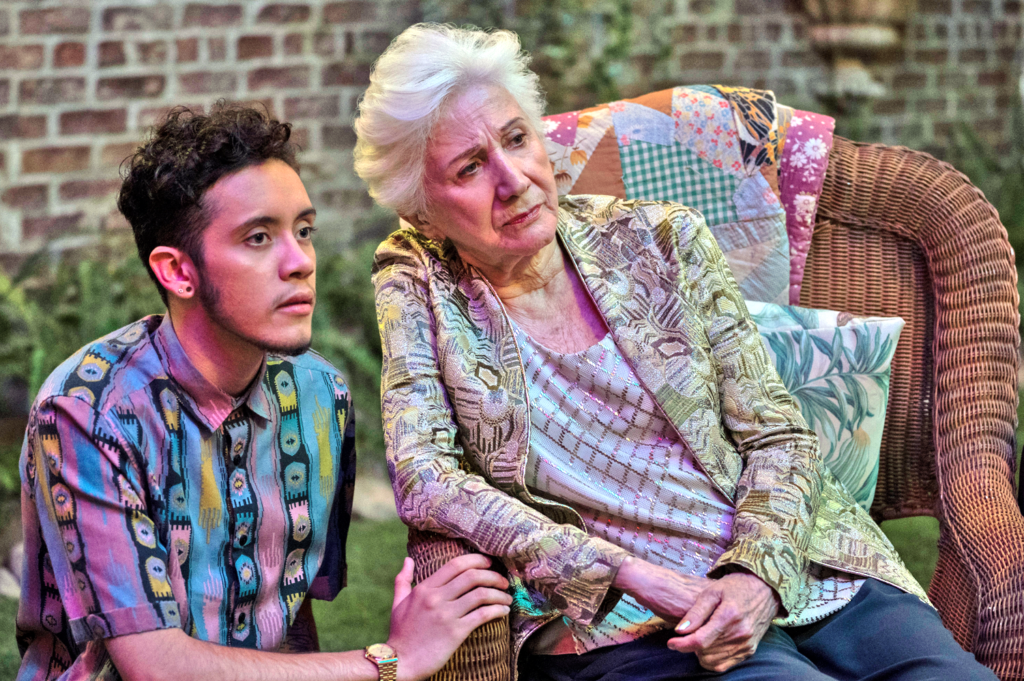
The differences between the books and the Netflix series could lead to some fascinating exegetical arguments between Tales of the City fans, and I would recommend if you like the series to read the books. But surprisingly, for such a beloved series with dozens of characters and intersecting storylines, there is no internet Tales of the City wiki. Perhaps the original Boomer fans of Tales aren’t as into the kinds of intense online parsing of characters and plots originated by Gen X and Millennials. Or perhaps the live-and-let-live bohemian ethos of Barbary Lane allows for the existence of a multiverse of stories.
Whatever the changes from the novels, the series catches us up with a few old friends and makes a lot of new ones. Not the least of which is the City by the Bay, which reveals there’s still enough magic in it to weave together the lives of strange and wonderful people into rich tapestries of chosen family.
